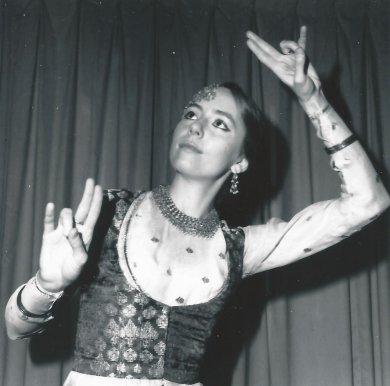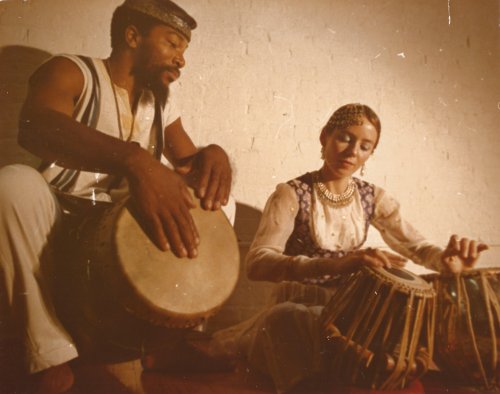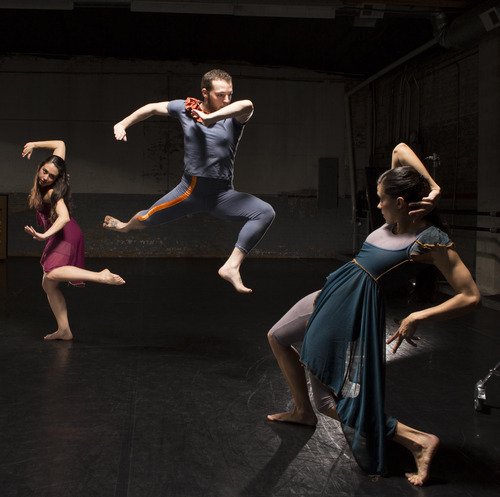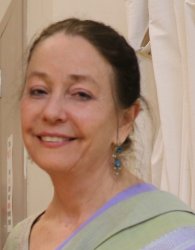
|   |

|   |
 e-mail: janakipatrik@gmail.com First Steps Photos courtesy: Janaki Patrik February 6, 2020 I didn't set out to be a choreographer. I would have been happy if someone else made dances for me. But that just didn't happen. When I returned to Chicago in 1969 after my initial training at Kathak Kendra, there was no ready-made niche waiting for me to fill. Very few people even knew what classical Indian dance looked like. If I tried to describe Kathak, people would rotate their hips and waggle their heads, saying, "Oh, like belly dance . . . . ?" I performed in the Indian student organizations at the University of Chicago, Illinois Institute of Technology and Northwestern University. But I was limited to giving lecture-demonstrations accompanied by music on two reels which Maharaj-ji and musicians had recorded at the Sangeet Natak studios in 1969. The same recorded music - time-after-time.  Performance on 5 Apr 1970 for Northwestern Univ Indian Students Organization Photo: Pranab Roychowdhury Searching for creative ways to perform Kathak and interact with the local arts scene, I connected with Shirley Genther at Urban Gateways Chicago, an early arts-in-education organization. Part of its mission was to bring performances into public schools. Calling our program 'Dances of the Earth,' Ms. Genther brought together me and Afro-American dancer Darlene Blackburn, who had studied dance in Nigeria and brought its traditional repertoire home to Chicago. She was accompanied by djembe drummer Brother Harold. Ms. Genther's concept was to present two non-western dance styles, which were both performed barefoot and told stories with gestures, not spoken words. Because rhythm provides the basic structure in both African and Indian dance, Brother Harold and I would demonstrate our drums and then played a duet.  Brother Harold and Janaki Patrik playing djembe and tabla together My first formal experience of choreographing resulted, because Ms. Genther envisioned a conversation between two cultures, not a shopping list of solo dances from India and Africa. Storytelling gave us the key. Darlene's repertoire included a dance about a flirtatious village girl being teased by a village boy. I chose a Radha-Krishna cherchal gat bhav* as the basis for my "conversation" with Darlene's dance. (*cherchal - teasing; gat bhav - storytelling in which characters and situations are created not by words but by distinctive walking patterns.) There it was - our choreographic springboard. We took turns portraying our versions of the shy village girl, each of us entering from opposite sides of the stage, then meeting in the middle for a finale arranged like a jugalbandi. "Ready-made" choreography? Yes, in a sense. But finding a way to interact with African dance challenged me to use the abhinaya I had learned in my Kathak training to tell my story and respond to Darlene's. Whatever hesitation I had about starting the exalted process of CHOREOGRAPHY held no sway over the necessity of "just doing it." Building on a Kathak foundation When I returned to the United States in 1969, I had by no means finished my Kathak training. Not finding any Kathak guru in Chicago, I turned to Western dance to extend my technique and continue the physical discipline every dancer needs to maintain. In 1969 modern dancer, choreographer and dance educator Shirley Mordine had just moved from San Francisco to Chicago, where she founded The Dance Center at Columbia College. My timing was fortunate. Still in the process of organizing her dance company and classes, Ms. Mordine had not yet formally created a syllabus with levels of training. Perhaps this is the reason she allowed me to study in her technique classes, though I was a total novice in western dance. Experiencing a new system of dance training, I also absorbed valuable lessons from Ms. Mordine about improvisation as a choreographic process. Starting class with a warmup, Ms. Mordine quickly moved into guided improvisations, not "steps and combinations." Dancers responded to each other's emotion-filled gestures, finding openings into each other's improvisations. Ms. Mordine didn't give students a chance to hold back. Instigating movement and encouraging dancers to push interesting groupings and pathways further, she coached us from the sidelines with her voice. Improvisations coalesced into nascent choreography, and she'd excitedly say, "Keep that!"  Mordine & Company Dance Theater For a brief decade from 1965 to 1975, the Harper Dance Festival brought dance companies to Chicago for one-week residencies. Each company offered several performances, lecture-demonstrations for school children and master classes for Chicago area dancers. In 1970 and 1971, I volunteered at the Harper Festival and attended every event presented by every dance company which visited, including Jose Limon, Martha Graham, Alwin Nikolais, Murray Louis, Merce Cunningham, Jennifer Muller, Louis Falco, Paul Taylor, Eric Hawkins. It was a Who's Who of major modern dance choreographers. Having taken master classes in all these techniques, seen their performances and heard the choreographers' comments about their choreography, I decided that the Merce Cunningham technique would reinforce my training in Kathak. Moreover, I was fascinated by Merce's witty, brilliant and unpredictable choreography, and I was impressed by his superb dancers. I would study with Merce.  Trained in both classical Kathak dance (Pt. Birju Maharaj, beginning 1967) and Merce Cunningham modern dance technique (1971 to 1978), Janaki Patrik has choreographed thirty full-evening productions and numerous shorter works exploring an eclectic range of poetry, mythic storytelling and music. She is the Artistic Director and Founder (1978) of The Kathak Ensemble & Friends/CARAVAN, NYC. A dedicated teacher, Janaki has trained dancers to perform an extensive repertoire of classical Kathak, as well as her new choreography. Teaching and performing in inner-city schools through Urban Gateways/Chicago and Young Audiences/New York for forty years, Janaki has embodied the power of dance and music to communicate the interconnections of all cultures. Post your comments Please provide your name and email id when you use the Anonymous profile in the blog to post a comment. All appropriate comments posted with name & email id in the blog will also be featured in the site. |